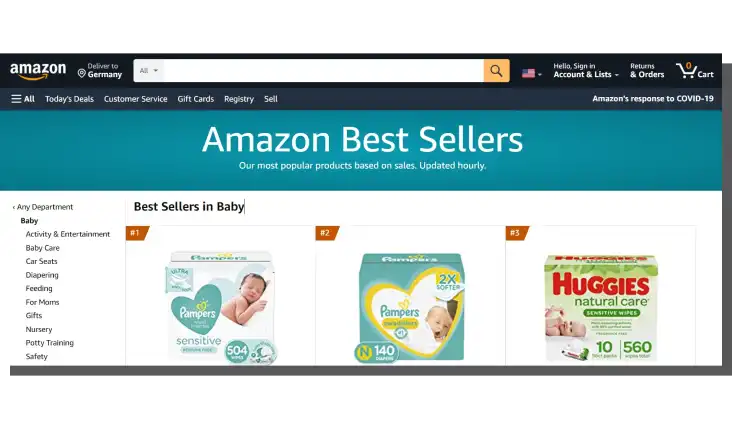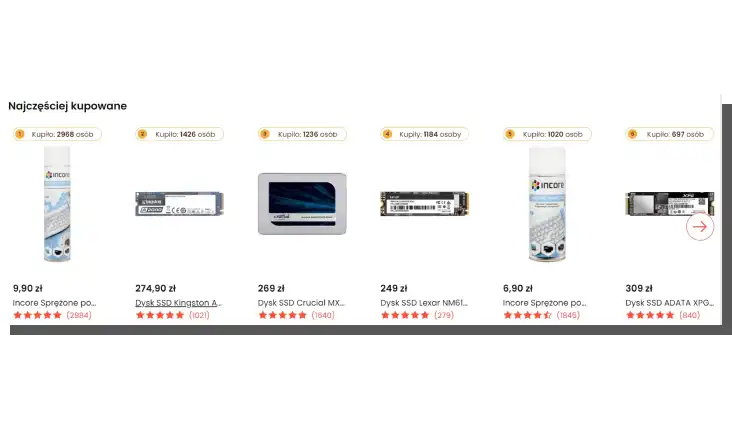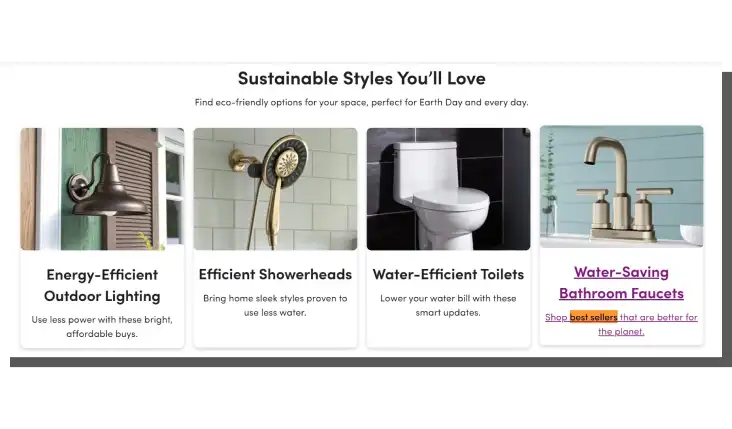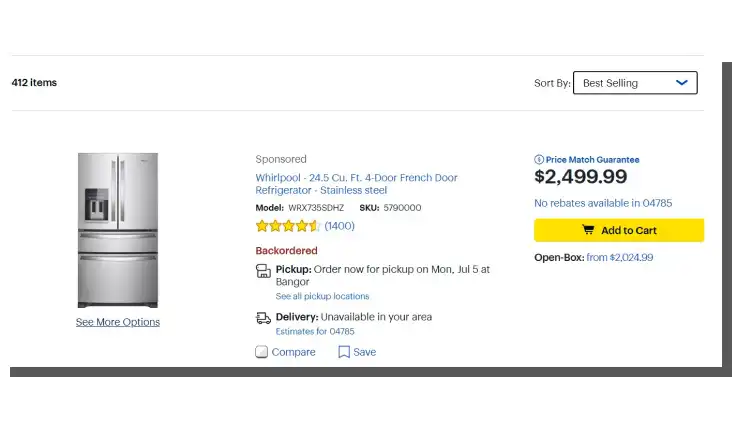Labels, icons, symbols, and highlights are signposts pointing in the direction of searches in an online store. They suggest results and provide arguments and evaluations.
They also point out popular products in the online store.
Everybody wants to buy fast, seamlessly, and comfortably, right? And icons and labels indicating Bestsellers are the best for this. It's challenging to sell products online without their help.
Today, we will pay more attention to the Bestsellers in E-Commerce because they're an effective way to increase sales in the online store.
If you're curious about how to highlight Bestsellers and how to design pages highlighted with the Bestsellers label, read this article.
We strongly recommend ourselves ;-) Without further ado, let's cut to the chase.
Bestsellers that is, the best-selling products
Rankings of popularity, sales, and profits (box-office success) always evoked powerful emotions. People follow them, evaluate them and bet how they will change.
It's hardly surprising.
Rankings are concrete and understandable indicators and success metrics.
Furthermore, they also express a more fundamental issue: the human tendency to mimic.
We are mimetic beings. We've known this for quite some time because of research within developmental psychology and pedagogy.

We imitate parents, peer groups, famous people, and those we trust and admire. We imitate at work, in daily life, and while doing grocery shopping.
As an interesting side note, we imitate not just our consumer choices but also deviant and criminal behaviors (copycat crimes).
In the literature on this subject, the phenomenon of imitating and succumbing to behavioral patterns and actions is quite well described. However, we will not delve into theoretical considerations here.
We just want to remind you about the Chameleon Effect, which involves involuntary, unconscious, and almost automatic mimicry. And we mimic each other in many dimensions. From language through appearance to actions.
We want to act similarly to people who stand out from the group or are positive role models.
From the perspective of E-Commerce User Experience, the level of sales volume in E-Commerce, the level of conversion rate, and interaction design, the phenomenon of mimicry has a significant meaning.
Thanks to the phenomenon of mimicry, it's easy to sell in the online store.
Customers very often feel uncertain, in particular, when the offered product in the online store is:
- Expensive
- Technologically advanced (requires specialized knowledge)
- Belgons to experience goods (its evaluation requires testing and use)
- A product unknown from everyday experience
- A product that will be used for the first time
- A product influencing the status
- Fulfilling essential needs.
The nature of the E-Commerce Industry additionally strengthens this uncertainty. The purchase always involves a risk. This applies to various kinds of products without exceptions.

To reduce uncertainties and risks, offer customers information and functionalities that counteract them.
Customers expect the online store to provide credibility, objective data, and exhaustive information.
Information about the product's status, how others see it, and how it is evaluated influence the purchasing decision.
Bestsellers have this precise role. In the narrow sense, these are the most eagerly bought products. But not only.
These are also products that are indirect indicators, messages about the:
- Quality: quantity indirectly attests to the quality
- Uniqueness: the sales volume indicates some specific features that many people observed
- Indispensability: the Bestseller label suggests a specific value and role of the product in the consumers' life
- Acceptability: ownership is an expression of belonging to a group, owners, so it has a rewarding function
- Verifiability: the quantity indicates that the product was successfully tested
- Opportunity: Bestsellers often quickly disappear from the market due to the high demand; therefore, it is a kind of urgent reminder.
How to present the most popular products, that is, category pages with the label Bestsellers
While designing rankings and separate Bestsellers category pages as Amazon does, it's worth keeping in mind why the American giant puts so much effort into highlighting the best-selling products.

It's about Hick's Law which states that the time needed to make a decision will increase along with the number and complexity of offered elements.
In other words, a separate Bestsellers category is helpful because it allows interaction with the offer that is "the best of the best."
And this means that the online store customer can be more reassured when it comes to matters of:
- Quality
- Attractiveness
- Safety of purchase; the customer buys a product that is tested and popular
- Differences and similarities, the customer chooses between products that are slightly different
- Selection, the customers receive the essence of the market offer
- Adequacy and up-to-dateness of the product (presumably, these are the products that best meet the needs).
Narrowed choice allows customers to quickly decide with higher certainty regarding the rightness of choice.
It guarantees a much more smooth user experience. Enables users to use the store more effectively.
It's an important and effective element that provides a very good User Experience.
Offering products on separate category pages labeled as Bestsellers has one more psychological justification. We're talking about the Isolation Effect (also known as Von Restorff Effect). What is it about?
The separate Bestsellers category positively stands out against the background of homogeneous stimuli (standard categories in online stores). It draws attention to itself, is easier to remember, and thus easier to find when visiting again.
Bestsellers is also a category that is (in the case of certain products) widely discussed in media. Therefore it also raises interest due to positive context.
A model example of a Bestsellers category page design is Amazon, which creates separate Bestsellers rankings for every general category (e.g., Computers & Accessories) and a specific one (e.g., Table Accessories).
If the store's claims are to be believed, every ranking is updated hourly. Although this solution is far from the stock exchange; still a note of similar excitement echoes in it.
Naturally, rankings should be created based on objective metrics and indicators. In the case of Amazon, we're dealing with the Amazon Best Sellers Rank indicator. How it is calculated, like almost all indicators, it's secret.
What we know is that Amazon takes into account the following factors:
- Current and previous sales
- Price changes
- Applied discounts
- Comparisons with other products from the same category.
A huge advantage of this method is its up-to-dateness.
The up-to-dateness of the ranking is important information that provides valuable assurances. Such as that, the category includes products for which there is actual and confirmed demand.
Not only rankings can represent the demand.
It's also recommended to provide data on the number of sold units of the product in question.

However, the Bestseller category can't be:
- Purely declarative (lack of proof, assurances, and data lowers the credibility and arouses suspicions)
- Created as a collection of random items that belong to different categories
- Ahistorical, the most popular products are those that are always bought at a specific time
- Contradictory to other functionalities, e.g., rating systems and rankings.
Customers should have maximal trust in products that are the most popular.
A best practice is to offer convincing figures that show their attractiveness over time.
In the end, no product sells with equal frequency all the time.
Bestsellers should be presented as products that sell the best during a specific:
- Day
- Week
- Month
- Quarter
- Year (current and previous).
A shorter time perspective is more recommended for seasonal products.
Products used throughout the year, especially those that resist short-lived fads and trends, should be promoted over more extended periods.

A longer time perspective suggests that customers are dealing with a product that was not only desirable and in vogue but also met the expectations of many buyers over a long period.
It "defeated" similar, competitive products which didn't receive the same or higher interest.
Must have it! Sorting by sales volume
In the article "Allow Sorting by Price, User Rating, Best-Selling, and Newest," researchers from the renowned Baymard Institute state that stores, as a standard, should provide the ability to sort products according to the following:
- Price
- Average user rating
- Date of addition (Newest category)
- Sales volume (Best selling).
The justification for offering these kinds of sorting criteria has been well understood and documented by researchers from Baymard.

According to the results of usability tests conducted by them, users of online stores treat products labeled as Bestsellers in the following way:
- Place trust in them (even if their knowledge about them is minimal)
- Consider them credible: they treat a high sales volume as a social proof
- Regard them as better: they make positive attributions (they assign positive features to the product that belongs to the Top/Best-selling category)
- Recognize them as safe evidence: while ratings or rankings may raise distrust due to subjectivity and the risk of manipulation, the high sales volume is seen as objective and unbiased.
So if the store doesn't offer a separate category page for Bestsellers, it should provide the option to sort products by the most helpful and desired criteria on category and subcategory pages.

It's certainly more helpful for customers than sorting products alphabetically.
Bestsellers in an online store. Designing a Bestseller product page
The Product page is a special place in the online store. That's where the customers often decide to add a product to the shopping cart.
The Best Selling Product label is an essential piece of information that can speed up this decision and make it more certain.
One of the most popular and effective ways of distinguishing and presenting the best-selling products is to label them with the following:
- Icons
- Symbols
- Labels (Best Seller/Top Seller).
Icons symbols and labels should be conventional and in line with current design norms, thanks to which their understandability will be higher.
All markings should be:
- Visible
- Readable (this especially applies to icons that should be a simple visual message)
- Highlighted by strong color contrast
- Big enough to suggest their rank and status.
Products in the online store that are marked by them should be easy to recognize.
The Bestseller labels reassure customers that they deal with a unique and popular product that has received a lot of interest from the store's customers.
Information about its popularity and available ratings, opinions, and expert recommendations constitute a persuasive, strongly impactful, credible, and convincing purchase incentive.
How to increase sales in an online store with Bestsellers? Summary
- Labels, icons, and symbols are important hints in the online store.
- Bestsellers are an effective way to increase sales — they are a commonly understood indicator/metric of success.
- Humans are mimetic beings. We also imitate consumer behaviors.
- In terms of psychology, mimicry can be likened to the Chameleon Effect.
- Online store customers tend to imitate others, particularly when they're uncertain.
- Expensive products that require specialized knowledge or experience goods are sources of concern.
- Credible information about the status, perception, and evaluation of a particular product by many people facilitates the purchasing decision.
- In this particular case, the amount indicates the quality.
- Bestsellers are indirect indicators of uniqueness, indispensability, and attractiveness.
- The Bestseller label facilitates the choice because it gives the customers a sense that they are dealing with an offer that is "best of the best."
- The Bestseller category includes products for which there is actual and confirmed demand.
- The Bestseller category can't be declarative, random, ahistorical, or contradictory to other functionalities (such as an average of ratings).
- Customers should have maximal trust in the most popular products.
- Online stores should provide the option to sort products by, among other things, sales volume (Best Selling).
- Online store users put their trust in products labeled as Bestsellers finding them more attractive and convincing.






